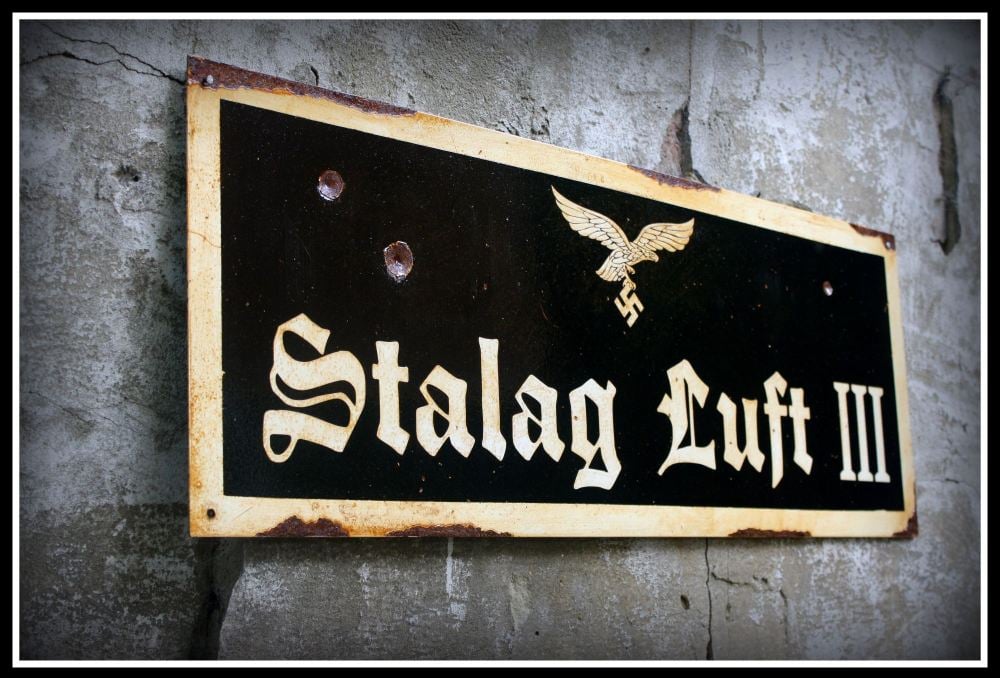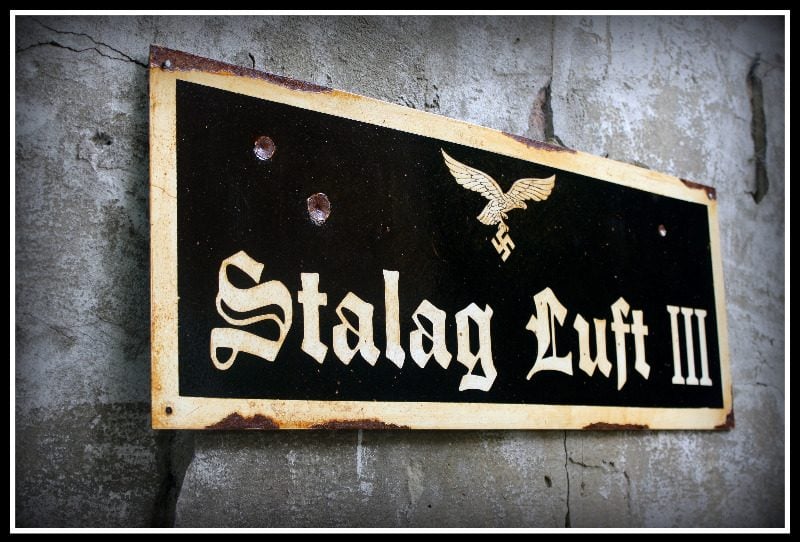
-
Stalag Luft III
- Steel sign. 833mm x 310mm
- £79.95

Stalag Luft III
Stalag Luft III (Stammlager Luft, or main camp for aircrew) was a Luftwaffe-run prisoner-of-war camp during World War II that housed captured air force servicemen. It was in the German province of Lower Silesia near the town of Sagan, 100 miles (160 km) southeast of Berlin. The site was selected because it would be difficult to escape by tunneling.
The camp is best known for two famous prisoner escapes that took place there by tunneling, which were depicted in the films The Great Escape (1963) and The Wooden Horse (1950) and the books by former prisoners Paul Brickhill and Eric Williams from which these films were adapted.
The camp was very secure. Despite being an officers-only camp, it was referred to as a Stalag camp rather than Oflag (Offizier Lager) as the Luftwaffe had their own nomenclature. Later camp expansions added compounds fo non-commissioned officers. Captured Fleet Air Arm (Royal Navy) crew were considered to be Air Force by the Luftwaffe and no differentiation was made. At times non-airmen were interned.
The first compound (East Compound) of the camp was completed and opened on 21 March 1942. The first prisoners, or kriegies, as they called themselves (from Kriegsgefangene), to be housed at Stalag Luft III were British and Commonwealth airmen as well as Fleet Air Arm officers, arriving in April 1942. The Centre compound was opened on 11 April 1942, originally for British sergeants but by the end of 1942 replaced by Americans. The North Compound for British airmen, where the Great Escape occurred, opened on 29 March 1943. A South Compound for Americans was opened in September 1943 and USAAF prisoners began arriving at the camp in significant numbers the following month and the West Compound was opened in July 1944 for U.S. officers. Each compound consisted of fifteen single story huts. Each 10-by-12-foot (3.0 m × 3.7 m) bunkroom slept fifteen men in five triple deck bunks. Eventually the camp grew to approximately 60 acres (24 ha) in size and housed about 2,500 Royal Air Force officers, about 7,500 U.S. Army Air Forces, and about 900 officers from other Allied air forces, for a total of 10,949 inmates, including some support officers.
The prison camp had a number of design features that made escape extremely difficult. The digging of escape tunnels, in particular, was discouraged by several factors, the barracks housing the prisoners were raised approximately 60 centimetres (24 in). off the ground to make it easier for guards to detect tunneling, the camp had been constructed on land that had a very sandy subsoil. The sand was bright yellow, so it could easily be detected if anyone dumped it on the surface (which consisted of grey dust) or even just had some of it on their clothing. The loose, collapsible sand meant the structural integrity of any tunnel would be very poor. A third defence against tunneling was the placement of siesmograph microphones around the perimeter of the camp, which were expected to detect any sounds of digging.
The first escape occurred in October 1943 in the East Compound. Conjuring up a modern Trojan Horse,the kriegies constructed a gymnastic vaulting horse largely from plywood from Red Cross parcels. The horse was designed to conceal men, tools and containers of soil. Each day the horse was carried out to the same spot near the perimeter fence and while prisoners conducted gymnastic exercises above, a tunnel was dug. At the end of each working day, a wooden board was placed over the tunnel entrance and covered with surface soil. The gymnastics disguised the real purpose of the vaulting horse and kept the sound of the digging from being detected by the microphones. For three months three prisoners, Lieutenant Michael Codner, Flight Lieutenant Eric Williams and Flight Lieutenant Oliver Philpot, in shifts of one or two diggers at a time, dug over 100 feet (30 m) of tunnel, using bowls as shovels and metal rods to poke through the surface of the ground to create air holes. No shoring was used except near the entrance. On the evening of 19 October 1943, Codner, Williams and Philpot made their escape.Williams and Codner were able to reach the port of Stettin where they stowed away on a Danish ship and eventually returned to Britain. Philpot, posing as a Norwegian margarine manufacturer, was able to board a train to Danzig (now Gdansk) and from there stowed away on a Swedish ship headed for Stockholm, from where he was repatriated to Britain. Accounts of this escape, long overshadowed by The Great Escape, were recorded in the book Goon in the Block (later retitled The Wooden Horse) by Williams, the book Stolen Journey by Philpot and the 1950 film The Wooden Horse.
